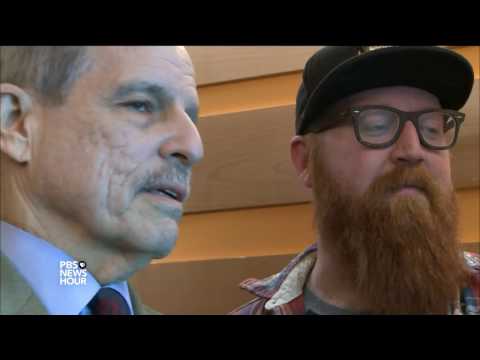6.10: Common Organizational Structures
- Page ID
- 47668
\( \newcommand{\vecs}[1]{\overset { \scriptstyle \rightharpoonup} {\mathbf{#1}} } \)
\( \newcommand{\vecd}[1]{\overset{-\!-\!\rightharpoonup}{\vphantom{a}\smash {#1}}} \)
\( \newcommand{\dsum}{\displaystyle\sum\limits} \)
\( \newcommand{\dint}{\displaystyle\int\limits} \)
\( \newcommand{\dlim}{\displaystyle\lim\limits} \)
\( \newcommand{\id}{\mathrm{id}}\) \( \newcommand{\Span}{\mathrm{span}}\)
( \newcommand{\kernel}{\mathrm{null}\,}\) \( \newcommand{\range}{\mathrm{range}\,}\)
\( \newcommand{\RealPart}{\mathrm{Re}}\) \( \newcommand{\ImaginaryPart}{\mathrm{Im}}\)
\( \newcommand{\Argument}{\mathrm{Arg}}\) \( \newcommand{\norm}[1]{\| #1 \|}\)
\( \newcommand{\inner}[2]{\langle #1, #2 \rangle}\)
\( \newcommand{\Span}{\mathrm{span}}\)
\( \newcommand{\id}{\mathrm{id}}\)
\( \newcommand{\Span}{\mathrm{span}}\)
\( \newcommand{\kernel}{\mathrm{null}\,}\)
\( \newcommand{\range}{\mathrm{range}\,}\)
\( \newcommand{\RealPart}{\mathrm{Re}}\)
\( \newcommand{\ImaginaryPart}{\mathrm{Im}}\)
\( \newcommand{\Argument}{\mathrm{Arg}}\)
\( \newcommand{\norm}[1]{\| #1 \|}\)
\( \newcommand{\inner}[2]{\langle #1, #2 \rangle}\)
\( \newcommand{\Span}{\mathrm{span}}\) \( \newcommand{\AA}{\unicode[.8,0]{x212B}}\)
\( \newcommand{\vectorA}[1]{\vec{#1}} % arrow\)
\( \newcommand{\vectorAt}[1]{\vec{\text{#1}}} % arrow\)
\( \newcommand{\vectorB}[1]{\overset { \scriptstyle \rightharpoonup} {\mathbf{#1}} } \)
\( \newcommand{\vectorC}[1]{\textbf{#1}} \)
\( \newcommand{\vectorD}[1]{\overrightarrow{#1}} \)
\( \newcommand{\vectorDt}[1]{\overrightarrow{\text{#1}}} \)
\( \newcommand{\vectE}[1]{\overset{-\!-\!\rightharpoonup}{\vphantom{a}\smash{\mathbf {#1}}}} \)
\( \newcommand{\vecs}[1]{\overset { \scriptstyle \rightharpoonup} {\mathbf{#1}} } \)
\( \newcommand{\vecd}[1]{\overset{-\!-\!\rightharpoonup}{\vphantom{a}\smash {#1}}} \)
\(\newcommand{\avec}{\mathbf a}\) \(\newcommand{\bvec}{\mathbf b}\) \(\newcommand{\cvec}{\mathbf c}\) \(\newcommand{\dvec}{\mathbf d}\) \(\newcommand{\dtil}{\widetilde{\mathbf d}}\) \(\newcommand{\evec}{\mathbf e}\) \(\newcommand{\fvec}{\mathbf f}\) \(\newcommand{\nvec}{\mathbf n}\) \(\newcommand{\pvec}{\mathbf p}\) \(\newcommand{\qvec}{\mathbf q}\) \(\newcommand{\svec}{\mathbf s}\) \(\newcommand{\tvec}{\mathbf t}\) \(\newcommand{\uvec}{\mathbf u}\) \(\newcommand{\vvec}{\mathbf v}\) \(\newcommand{\wvec}{\mathbf w}\) \(\newcommand{\xvec}{\mathbf x}\) \(\newcommand{\yvec}{\mathbf y}\) \(\newcommand{\zvec}{\mathbf z}\) \(\newcommand{\rvec}{\mathbf r}\) \(\newcommand{\mvec}{\mathbf m}\) \(\newcommand{\zerovec}{\mathbf 0}\) \(\newcommand{\onevec}{\mathbf 1}\) \(\newcommand{\real}{\mathbb R}\) \(\newcommand{\twovec}[2]{\left[\begin{array}{r}#1 \\ #2 \end{array}\right]}\) \(\newcommand{\ctwovec}[2]{\left[\begin{array}{c}#1 \\ #2 \end{array}\right]}\) \(\newcommand{\threevec}[3]{\left[\begin{array}{r}#1 \\ #2 \\ #3 \end{array}\right]}\) \(\newcommand{\cthreevec}[3]{\left[\begin{array}{c}#1 \\ #2 \\ #3 \end{array}\right]}\) \(\newcommand{\fourvec}[4]{\left[\begin{array}{r}#1 \\ #2 \\ #3 \\ #4 \end{array}\right]}\) \(\newcommand{\cfourvec}[4]{\left[\begin{array}{c}#1 \\ #2 \\ #3 \\ #4 \end{array}\right]}\) \(\newcommand{\fivevec}[5]{\left[\begin{array}{r}#1 \\ #2 \\ #3 \\ #4 \\ #5 \\ \end{array}\right]}\) \(\newcommand{\cfivevec}[5]{\left[\begin{array}{c}#1 \\ #2 \\ #3 \\ #4 \\ #5 \\ \end{array}\right]}\) \(\newcommand{\mattwo}[4]{\left[\begin{array}{rr}#1 \amp #2 \\ #3 \amp #4 \\ \end{array}\right]}\) \(\newcommand{\laspan}[1]{\text{Span}\{#1\}}\) \(\newcommand{\bcal}{\cal B}\) \(\newcommand{\ccal}{\cal C}\) \(\newcommand{\scal}{\cal S}\) \(\newcommand{\wcal}{\cal W}\) \(\newcommand{\ecal}{\cal E}\) \(\newcommand{\coords}[2]{\left\{#1\right\}_{#2}}\) \(\newcommand{\gray}[1]{\color{gray}{#1}}\) \(\newcommand{\lgray}[1]{\color{lightgray}{#1}}\) \(\newcommand{\rank}{\operatorname{rank}}\) \(\newcommand{\row}{\text{Row}}\) \(\newcommand{\col}{\text{Col}}\) \(\renewcommand{\row}{\text{Row}}\) \(\newcommand{\nul}{\text{Nul}}\) \(\newcommand{\var}{\text{Var}}\) \(\newcommand{\corr}{\text{corr}}\) \(\newcommand{\len}[1]{\left|#1\right|}\) \(\newcommand{\bbar}{\overline{\bvec}}\) \(\newcommand{\bhat}{\widehat{\bvec}}\) \(\newcommand{\bperp}{\bvec^\perp}\) \(\newcommand{\xhat}{\widehat{\xvec}}\) \(\newcommand{\vhat}{\widehat{\vvec}}\) \(\newcommand{\uhat}{\widehat{\uvec}}\) \(\newcommand{\what}{\widehat{\wvec}}\) \(\newcommand{\Sighat}{\widehat{\Sigma}}\) \(\newcommand{\lt}{<}\) \(\newcommand{\gt}{>}\) \(\newcommand{\amp}{&}\) \(\definecolor{fillinmathshade}{gray}{0.9}\)- Differentiate between the four basic types of departmentalization (function, product, customer, and geography).
- Distinguish matrix organizations from traditional departments.
- Differentiate between team-based structures, networks, and modular organizations.
Departmentalization
Based on an organization’s application of the common elements—common purpose, coordinated effort, division of labor, hierarchy of authority, as well as centralization/decentralization and formalization—the resulting structure will typically exhibit one of four broad departmental structures: functional, product, customer, and geographic.
Functional Structure
As sales increase, organizations generally adopt a functional structure. This structure groups employees into functional areas based on their expertise. These functional areas often correspond to stages in the value chain such as operations, research and development, and marketing and sales. They also include support areas such as accounting, finance, and human resources. The graphic that follows shows a functional structure, with the lines indicating reporting and authority relationships. The department head of each functional area reports to the CEO; the CEO then coordinates and integrates the work of each function.

A functional structure allows for a higher degree of specialization and deeper domain expertise than a simple structure. Higher specialization also allows for a greater division of labor, which is linked to higher productivity.[1] Although work in a functional structure tends to be specialized, it is centrally coordinated by the CEO, as in the earlier graphic. A functional structure allows for an efficient top-down and bottom-up communication chain between the CEO and the functional departments, and thus relies on a relatively tall structure. The disadvantage inherent to a functional structure is that the emphasis on specialization can cause high levels of job dissatisfaction and fewer process improvements for the business.
Product Structure
Companies with diversified product lines frequently structure based on the product or service. GE, for example, has structured six product-specific divisions supported by six centralized service divisions. (1) Energy, (2) Capital (3) Home & Business Solutions, (4) Healthcare, (5) Aviation, and (6) Transportation. Product divisions work well where products are more technical and require more specialized knowledge. These product divisions are supported by centralized services, which include: public relations, business development, legal, global research, human resources, and finance.
This type of structure is ideal for organizations with multiple products and can help shorten product development cycles. One disadvantage is that it can be difficult to scale. Another disadvantage is that the organization may end up with duplicate resources as different divisions strive for autonomy.
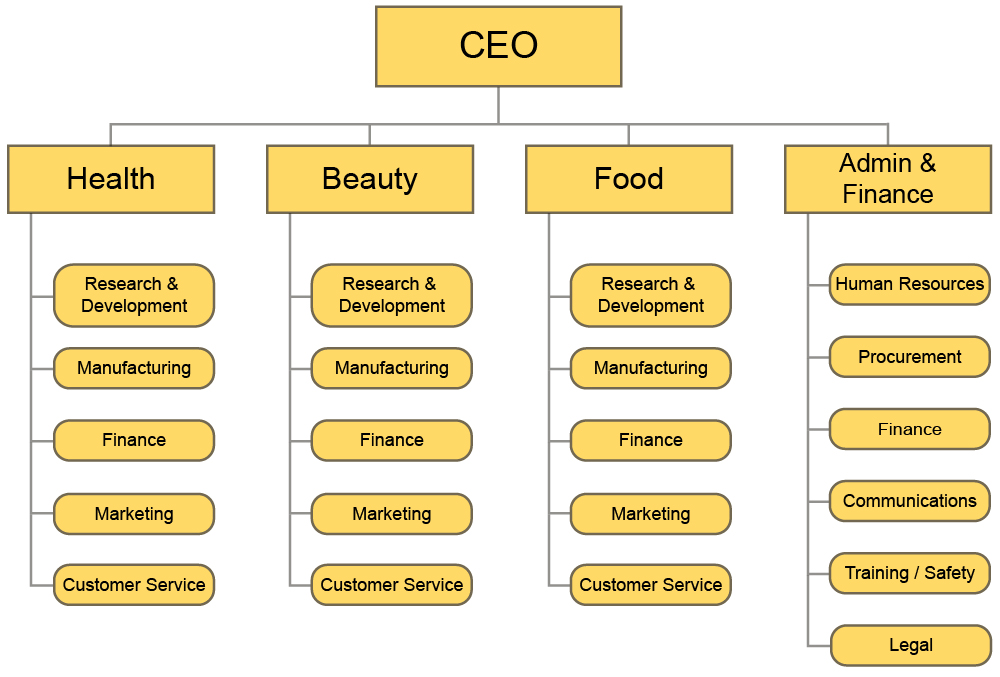
Customer Structure
Companies that offer services, such as health care, tend to use a customer-based structure. While similar to the product structure, the different business segments at the bottom are each split into a specific customer group—for example, outpatient, urgent care, and emergency care patients. Since the customers differ significantly, it makes sense to customize the service. Employees can specialize around the type of customer and be more productive with that type of customer. The directors of each customer center would report directly to the chief medical officer and/or the hospital CEO. This is also designed to avoid overlap, confusion, and redundancies. The customer structure is appropriate when the organization’s product or service needs to be tailored to specific customers.
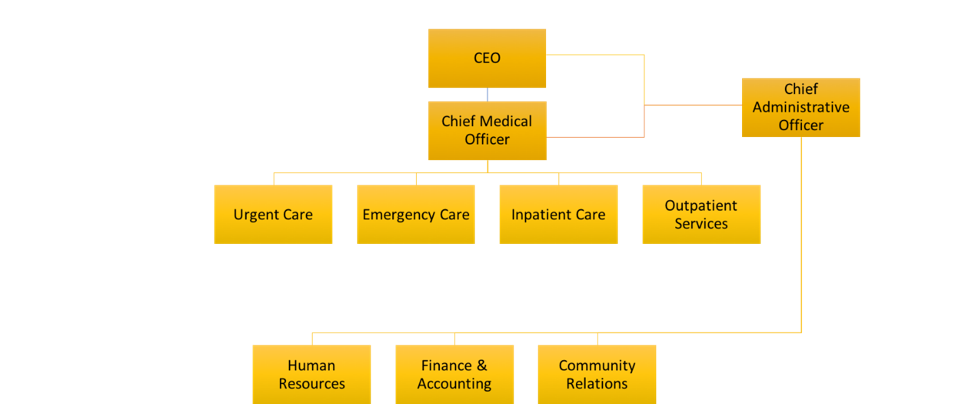
The customer-based structure is ideal for an organization that has products or services unique to specific market segments, especially if that organization has advanced knowledge of those segments. However, there are disadvantages to this structure, too. If there is too much autonomy across the divisions, incompatible systems may develop. Or divisions may end up inadvertently duplicating activities that other divisions are already managing.
Geography Structure
If an organization spans multiple geographic regions, and the product or service needs to be localized, it often requires organization by region. Geographic structuring involves grouping activities based on geography, such as a Latin American division. Geographic structuring is especially important if tastes and brand responses differ across regions, as it allows for flexibility in product offerings and marketing strategies. Also, geographic structuring may be necessary because of cost and availability of resources, distribution strategies, and laws in foreign countries. Coca Cola structures geographically because of the cost of transporting water. NetJets, a private aviation company, had to create a separate company in Portugal to operate NetJets Europe, because the entity had to be owned by a European Union carrier.
McDonald’s is well-known for its geographic structure and localization strategy for food preferences. The McDonald’s in Malaysia is certified halal (no pork products) and you can order the McD Chicken Porridge: chicken and onions in porridge. Other examples are Brie Nuggets (fried brie) in Russia; the Ebi Filet-O (shrimp patty) in Japan; and in Canada, you can get poutine (fries and cheese curds smothered in gravy).
This type of structure is best for organizations that need to be near sources of supply and/or customers. The main disadvantage of a geographical organizational structure is that it can be easy for decision making to become decentralized; geographic divisions can sometimes be hundreds, if not thousands, of miles away from corporate headquarters, allowing them to have a high degree of autonomy.
Matrix Organizations
Where two dimensions are critical, companies will use a matrix structure. Employees may be organized according to product and geography, for example, and have two bosses. The idea behind this type of matrix structure is to combine the localization benefits of the geography structure with those of the functional structure (responsiveness and decentralized focus).
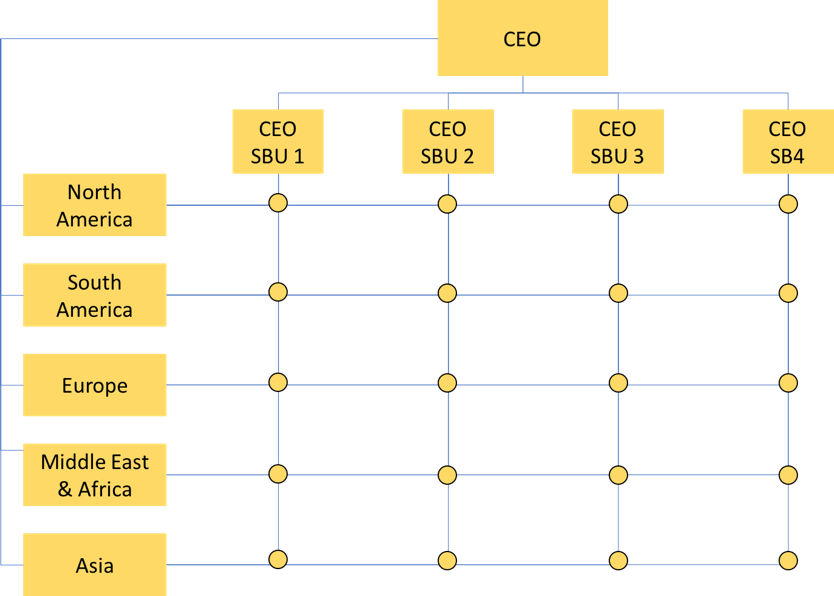
The advantage of the matrix structure is that it can provide both flexibility and more balanced decision making (because two chains of command exist instead of just one). Its primary disadvantage: complexity, which can lead to confused employees.
Team-based Structures, Networks, and Modular Organizations
The reality is that if an organization is successful enough to survive and grow, it will eventually need some form of integration. Poor communication between siloed departments often leads to a crisis that inspires efforts to integrate—efforts such as teams, networks, and modular structures.
Team-based Structure
Over the last several decades, team-based structures of some variation have become common in almost every industry. Lockheed Martin Aircraft Corporation started its “Skunk Works” project in 1943 in response to the U.S. Army’s need for a jet fighter. Based on a handshake, a small team of engineers worked secretly in a tent to design and build the XP-80 Shooting Star Jet Fighter in 143 days—seven days less than was required. The level of secrecy needed for this type of a project team is extremely rare in most organizations, yet it did spawn the modern-day project team.
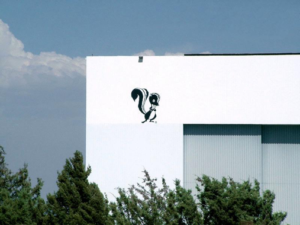
Project teams are focused on a few objectives and usually disbanded at a project’s end. Similar to the Skunk Works® model, this team may locate in a designated room or building with the intention to increase communication and collaboration and minimize distractions. Although project teams are less hierarchical, they typically still include a manager.
Team
In general, a team is made up of people with complementary skills who are working toward a common purpose. Organizations create teams by grouping employees in a way that generates a variety of expertise and addresses a specific operational component of the organization. Teams that include members from different functions are known as cross-functional teams. Because of the success of early project teams, the belief is that a team will be a more creative and productive structure to face new challenges. It is important to remember, however, that every team is a group but not every group is a team. A team structure must be less hierarchical, share the leadership, and be more fluid than traditional structures (such as functional or divisional). True teams do not disband after a project. Rather, they continue to change and adapt to fulfill group and organizational objectives over several years.
The following table lists some of the differences between teams and groups.
| Teams | Groups | |
|---|---|---|
| Purpose | Distinct, specific to the team’s charter | Indistinguishable from, or parallels that of, the organization |
| Work | Interdependent with a collective work product | Independent tasks with individual work products |
| Performance | Synergy – collectively we achieve more than the sum of individual efforts | Additive – the sum of the individual efforts |
| Skills | Complementary | Job-specific |
| Leadership | Shared | One leader |
| Accountability | Mutual accountability, responsibility for the collective work product | Individuals: For their own products Leader: For group product |
| Communication | Performance conversations | Hierarchical |
Source: Information derived from Katzenbach and Smith (1993)
Team structures can eliminate layers of management, which allows employees to make decisions without getting multiple approvals. This streamlines processes and lowers administrative costs. However, motivating individuals in a team-based organization can be more challenging as team accomplishments are rewarded rather than individual achievements.
Network Structure
The newest, and most divergent, team structure is commonly known as a network structure. A network structure has little bureaucracy and features decentralized decision making. Managers coordinate and control relations both internal and external to the firm. A social structure of interactions is fostered to build and manage formal and informal relationships. The goal of this structure is to achieve rapid organizational evolution and adaptation to constantly changing external and internal environments.
Zappos has embraced this model and labeled it holacracy. Rather than relying on a traditional top-down hierarchical management structure, holacracy attempts to achieve control and coordination by distributing power and authority to self-organizing groups (so-called circles) of employees. Circles of employees are meant to self-organize and own a specific task, such as confirming online orders or authorizing a customer’s credit card. Order is supposed to emerge from the bottom up, rather than rely on top-down command and control as in traditional organizational structures. Rules are explicit in a so-called constitution, which defines the power and authority of each circle. For coordination, the employee circles overlap horizontally and without vertical hierarchy. Once the teams are in place, the CEO effectively relinquishes all executive powers.
A network structure is meant to promote communication and the free flow of information between different parts of the organization as needed. However, the circular structure can be confusing, especially for new employees.[2]
The following video explores Zappos’ work culture and organizational structure.
Modular Organizations
A business that has areas or departments that can be easily separated from the company without jeopardizing the company are considered to have a modular organizational structure. The key lies in the ability to identify which modules, or departments, of a business are effective and which can be outsourced to create a tighter organization.
Organizations that want to remain flexible and streamlined must know when it is time to remove a module and allow the job to be done outside the company. For example, a small specialty T-Shirt company may recognize that its design, production, and customer service modules are at peak form and working well together but that its website design and maintenance department is slowing it down. The shop may externalize that module and send the work to an outside business.[3]
- Andrew J. Epstein, Jonathan D Ketcham, and Sean Nicholson, “Specialization and Matching in Professional Services Firm,” RAND Journal of Economics. 41, no. 4 (Winter 2010) 811–834. p. 824. ↵
- Devaney, Erik. “The Pros & Cons of 7 Popular Organizational Structures [Diagrams].” HubSpot Marketing. Dec. 23, 2014 (updated Aug. 3, 2017). https://blog.hubspot.com/marketing/team-structure-diagrams↵
- Sparks, Dana. “Modularity Organization Structure.” Houston Chron. http://smallbusiness.chron.com/modularity-organization-structure-12822.html↵
Contributors and Attributions
- Common Organizational Structures. Authored by: David J. Thompson, Ph.D. and Lumen Learning. License: CC BY: Attribution
- Image: Functional Structure Organizational Chart. Authored by: David J. Thompson, PhD, and Lumen Learning. License: CC BY: Attribution
- Image: Customer Structure Organizational Chart. Authored by: David J. Thompson, PhD, and Lumen Learning. License: CC BY: Attribution
- Image: Matrix Structure with Geographic and Product (SBU) Structure. Authored by: David J. Thompson, PhD, and Lumen Learning. License: CC BY: Attribution
- Video: Zappos is a weird company u2013 and itu2019s happy that way. Authored by: PBS NewsHour. Located at: https://www.youtube.com/watch?v=5mknIg_Abfw. License: All Rights Reserved
- Skunkworks-logo. Authored by: Malfita. Located at: https://commons.wikimedia.org/wiki/File:Skunkworks-logo.jpg. License: Public Domain: No Known Copyright



